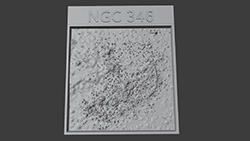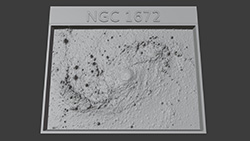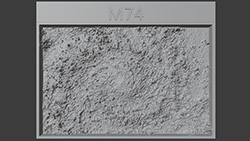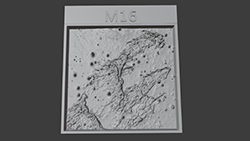CXC Home | Search | Help | Image Use Policy | Latest Images | Privacy | Accessibility | Glossary | Q&A
1
X-ray, Infrared, & Optical ImagesCredit: X-ray: Chandra: NASA/CXC/SAO, XMM: ESA/XMM-Newton; IR: JWST: NASA/ESA/CSA/STScI, Spitzer: NASA/JPL/Caltech; Optical: Hubble: NASA/ESA/STScI, ESO; Image Processing: L. Frattare, J. Major, N. Wolk, and K. Arcand, with additional support on NGC 346 by A. Kudrya
Four new composite images including X-rays from Chandra and infrared data from Webb feature two galaxies, a nebula, and a star cluster. Data from Hubble (optical light) and retired Spitzer (infrared), plus XMM-Newton (X-ray) and the New Technology Telescope (optical) is also used. X-rays generally reveal more energetic and hotter phenomena than infrared light. The objects in this new collection, beginning in the upper left and moving clockwise, are NGC 346, a star cluster in the Small Magellanic Cloud, the barred spiral galaxy NGC 1672, Messier 16 (also known as the Eagle Nebula), and Messier 74, a spiral galaxy similar to the Milky Way.
2
Chandra & Webb 3D Printable Tactile Plates This release features four separate objects that combine X-ray data from the Chandra Observatory, infrared data from the James Webb Space Telescope, and data from other telescopes like Hubble, Spitzer and XMM-Newton. The detailed composite images are presented as four relief maps that can be 3D printed as tactile plates.
NGC 346 Tactile Plate
(3D Print Credit: NASA/CXC/A. Jubett & K.Arcand, using software by Tactile Universe/N. Bonne & C. Krawczyk & Blender)
(3D Print Credit: NASA/CXC/A. Jubett & K.Arcand, using software by Tactile Universe/N. Bonne & C. Krawczyk & Blender)
In the NGC 346 star cluster, thousands of specks of light blanket the image. A ribbon of thick cloud runs along the bottom edge of the image, rounds our lower right corner, and streaks up the right side. A similar patch of roiling cloud can be found near our upper left. Between these gas plumes, centered near the top of the image, the star cluster is densely packed with specks of light. At our left, a large dot is surrounded by speckled mist. This is a hot, young, massive star, sending powerful winds outward from its surface. A patch of smaller dots, other young stars, can be found near the center of the image.
NGC 1672 Tactile Plate
(3D Print Credit: NASA/CXC/A. Jubett & K.Arcand, using software by Tactile Universe/N. Bonne & C. Krawczyk & Blender)
(3D Print Credit: NASA/CXC/A. Jubett & K.Arcand, using software by Tactile Universe/N. Bonne & C. Krawczyk & Blender)
Spiral galaxy NGC 1672 is shown face on. This spiral galaxy has two major arms curving away from the swirling light at its core. One arm extends to our lower left with a gentle upward curve. The other extends to our upper right with a curve reminiscent of a question mark. Both arms have a cloudy quality, and are dotted with stars of varying sizes. In this galaxy, categorized as a “barred” spiral, the arms don’t seem to reach the raised core. The space around the core is a swirl of murky cloud.
M74 Tactile Plate
(3D Print Credit: NASA/CXC/A. Jubett & K.Arcand, using software by Tactile Universe/N. Bonne & C. Krawczyk & Blender)
(3D Print Credit: NASA/CXC/A. Jubett & K.Arcand, using software by Tactile Universe/N. Bonne & C. Krawczyk & Blender)
M74 is a spiral galaxy like our own Milky Way. Oriented face-on from our vantage point on Earth, the galaxy’s sparkling arms spiral out from a raised core. The core feels vibrant and dense, crackling with activity. High-energy stars dot the lengths of the spiraling arms. Webs of dust crisscross the space between the curving arms, also known as dust lanes.
M16, Eagle Nebula Tactile Plate
(3D Print Credit: NASA/CXC/A. Jubett & K.Arcand, using software by Tactile Universe/N. Bonne & C. Krawczyk & Blender)
(3D Print Credit: NASA/CXC/A. Jubett & K.Arcand, using software by Tactile Universe/N. Bonne & C. Krawczyk & Blender)
The Eagle Nebula is often referred to as the “Pillars of Creation”. In this image, tall columns of gas and dust emerge from the bottom edge of the plate, stretching toward our upper right. Backed by mist, the cloudy columns are surrounded by dozens of dots; massive stars emitting enormous amounts of X-rays. The shapes in this composite create a dream-like plane. Churning with turbulent gas and dust, the columns lean to our right with small offshoots pointing in the same direction. These details evoke a scene of yearning cloud creatures at dusk, pointing at something just out of frame.
Return to NASA's Chandra, Webb Combine for Arresting Views (May 23, 2023)























